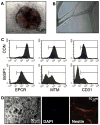Loss of Bright/ARID3a function promotes developmental plasticity
- PMID: 20680960
- PMCID: PMC2977942
- DOI: 10.1002/stem.491
Loss of Bright/ARID3a function promotes developmental plasticity
Abstract
B-cell regulator of immunoglobulin heavy chain transcription (Bright)/ARID3a, an A+T-rich interaction domain protein, was originally discovered in B lymphocyte lineage cells. However, expression patterns and high lethality levels in knockout mice suggested that it had additional functions. Three independent lines of evidence show that functional inhibition of Bright results in increased developmental plasticity. Bright-deficient cells from two mouse models expressed a number of pluripotency-associated gene products, expanded indefinitely, and spontaneously differentiated into cells of multiple lineages. Furthermore, direct knockdown of human Bright resulted in colonies capable of expressing multiple lineage markers. These data suggest that repression of this single molecule confers adult somatic cells with new developmental options.
Conflict of interest statement
Figures






References
-
- Herrscher RF, Kaplan MH, Lelsz DL, et al. The immunoglobulin heavy-chain matrix-associating regions are bound by Bright: a B cell-specific trans-activator that describes a new DNA-binding protein family. Genes Dev. 1995;9:3067–3082. - PubMed
-
- Wilsker D, Patsialou A, Dallas PB, et al. ARID proteins: a diverse family of DNA binding proteins implicated in the control of cell growth, differentiation, and development. Cell Growth Differ. 2002;13:95–106. - PubMed
-
- Wilsker D, Probst L, Wain HM, et al. Nomenclature of the ARID family of DNA-binding proteins. Genomics. 2005;86:242–251. - PubMed
-
- Peeper DS, Shvarts A, Brummelkamp T, et al. A functional screen identifies hDRIL1 as an oncogene that rescues RAS- induced senescence. Nat Cell Biol. 2002;4 :148–153. - PubMed
Publication types
MeSH terms
Substances
Grants and funding
LinkOut - more resources
Full Text Sources
Other Literature Sources
Molecular Biology Databases

